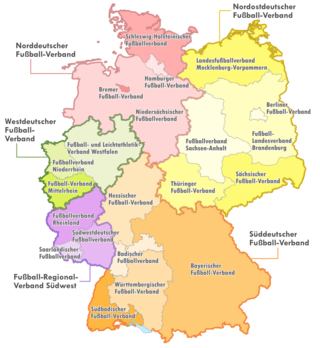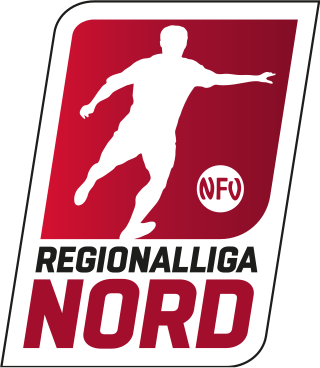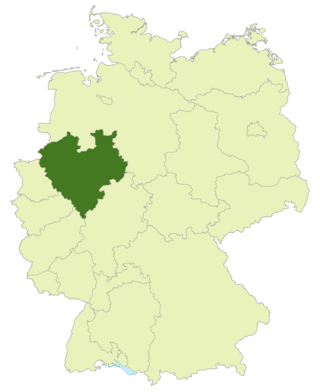Related Research Articles

The DDR-Oberliga was the top-level association football league in East Germany.

The Oberliga is the fifth tier of the German football league system. Before the introduction of the 3. Liga in 2008, it was the fourth tier. At the end of the 2011–12 season the number of Oberligas was increased from eleven to fourteen.

The Regionalliga is the fourth tier in the German football league system. Until 1974, it was the second tier in Germany. In 1994, it was introduced as the third tier. Upon the creation of the new nationwide 3. Liga in 2008, it became the fourth tier. While all of the clubs in the top three divisions of German football are professional, the Regionalliga has a mixture of professional and semi-professional clubs.
The German football league system, or league pyramid, refers to the hierarchically interconnected league system for association football in Germany that in the 2016–17 season consisted of 2,235 leagues in up to 13 levels having 31,645 teams, in which all divisions are bound together by the principle of promotion and relegation. The top three professional levels contain one division each. Below this, the semi-professional and amateur levels have progressively more parallel divisions, which each cover progressively smaller geographic areas. Teams that finish at the top of their division at the end of each season can rise higher in the pyramid, while those that finish at the bottom find themselves sinking further down. Therefore, in theory, it is possible for even the lowest local amateur club to rise to the top of the system and become German football champions one day. The number of teams promoted and relegated between the divisions varies, and promotion to the upper levels of the pyramid is usually contingent on meeting additional criteria, especially concerning appropriate facilities and finances.

The Regionalliga Nord is the fourth tier of the German football league system in the states of Lower Saxony, Schleswig-Holstein, Bremen and Hamburg. It is one of five leagues at this level, together with the Regionalliga Bayern, Regionalliga Nordost, Regionalliga Südwest and the Regionalliga West. Until the introduction of the 3. Liga in 2008 it was the third tier.

FC Schönberg is a German association football club from the city of Schönberg, Mecklenburg-Vorpommern.

The Oberliga Rheinland-Pfalz/Saar, formerly the Oberliga Südwest, is the highest regional football league for the Rhineland-Palatinate and Saarland states of Germany, organized by the Southwestern Regional Football Association. It is the fifth tier of the German football league system. It is one of fourteen Oberligas in German football, the fifth tier of the German football league system. Until the introduction of the 3. Liga in 2008 it was the fourth tier of the league system; before the introduction of the Regionalligas in 1994 the third tier.
The Promotion to the 2. Bundesliga was an end-of-season competition, held annually to determine the clubs that were promoted from the Amateurligas, later the Amateur Oberligas to the 2. Bundesligas. It was necessary because there were more third division champions then promotion spots available.

The Regionalliga Nordost is the fourth tier of German football in the states of Berlin, Brandenburg, Mecklenburg-Western Pomerania, Saxony-Anhalt, Saxony and Thuringia. These comprise the states of former East Germany as well as West Berlin.

The Oberliga Westfalen is the highest level football league in the region of Westphalia, which is part of the state of North Rhine-Westphalia. The league existed from 1978 to 2008, but was then replaced by the NRW-Liga, a new statewide league. With the reform of the league system in 2012, which reduced the Regionalliga West to clubs from North Rhine-Westphalia only and disbanded the NRW-Liga below it, the Oberliga Westfalen was reintroduced as the highest tier in the region and the fifth level overall in Germany. It is one of fourteen Oberligas in German football, the fifth tier of the German football league system.
The Amateur-Oberliga Berlin was the second tier of the German football league system in the city of West Berlin in Germany from 1947 until the formation of the Bundesliga in 1963, operating under the name of Amateurliga Berlin. After 1963, it was the third tier until 1991, when the league was disbanded. In 1974, the league changed its name from Amateurliga Berlin to Amateur-Oberliga Berlin.
The NOFV-Oberliga Nord is the fifth tier of the German football league system in the northern states of the former East Germany and West Berlin. It covers the German states of Berlin, Brandenburg, Mecklenburg-Western Pomerania and northern Saxony-Anhalt. It is one of fourteen Oberligas in German football. Until the introduction of the 3. Liga in 2008 it was the fourth tier of the league system, and until the introduction of the Regionalligas in 1994 the third tier.
The NOFV-Oberliga Mitte was the third tier of the German football league system in the central states of former East Germany and West Berlin. The league existed from 1991 to 1994. It covered the German states of Berlin, Brandenburg and Saxony-Anhalt.
The German amateur football championship was a national football competition in Germany organized by the German Football Association and in existence from 1950 to 1998.
The 1999–2000 Regionalliga was the sixth season of the Regionalliga as the third tier of German football. It was also the last season to be competed in four divisions. Teams were not only competing for promotion to the 2. Bundesliga, but also to qualify for the new two-division Regionalliga.
The 1994–95 Regionalliga season was the first year of the Regionalliga as the third tier of German football. There were four regional sections, Nord, Nordost, West-Südwest and Süd, each with eighteen teams. Most teams qualified from the Oberliga, which dropped to become a fourth-tier league, while five teams were relegated from the previous year's 2. Bundesliga. In the Nord section, four teams were promoted from the formerly fourth-tier Verbandsliga.

The Bischofswerdaer FV 08 is a German association football club from the town of Bischofswerda, Saxony.
The 2014–15 season of the Oberliga was the seventh season of the Oberligas at tier five of the German football league system and the 41st season overall since reintroduction of the Oberligas in 1974. The regular season started in July 2014 and finished on 14 June 2015, followed by relegation and promotion play-offs.
The 2017–18 Regionalliga was the tenth season of the Regionalliga, the sixth under the new format, as the fourth tier of the German football league system.
References
- ↑ "§ 47a der Spielordnung" (PDF). DFB.de (in German). German Football Association. pp. 62–63. Archived from the original (PDF) on 1 April 2018. Retrieved 28 May 2018.
- 1 2 3 "Meister Regionalliga Nord der Frauen" (in German). Deutscher Sportclub für Fußballstatistiken. 2008. Retrieved 23 July 2009.
- ↑ "Teams Regionalliga Frauen 2009/2010" (in German). NOFV. 2009. Archived from the original on 17 February 2012. Retrieved 25 July 2009.
- ↑ "NOFV-Meister" (in German). NOFV. 2009. Archived from the original on 7 April 2014. Retrieved 26 July 2009.
- 1 2 "Meister Regionalliga Süd der Frauen" (in German). Deutscher Sportclub für Fußballstatistiken. 2008. Retrieved 25 July 2009.
- ↑ Including teams from Baden, South Baden, and Württemberg
- 1 2 3 "Meister Regionalliga Südwest der Frauen" (in German). Deutscher Sportclub für Fußballstatistiken. 2008. Retrieved 24 July 2009.
- 1 2 "Meister Regionalliga West der Frauen" (in German). Deutscher Sportclub für Fußballstatistiken. 2008. Retrieved 21 July 2009.
- ↑ "Geschichte der Regionalliga West der Frauen" (in German). Retrieved 26 May 2015.
- ↑ "Geschichte der Frauen-Regionalliga Südwest" (in German). Retrieved 26 May 2015.
- ↑ "Geschichte der Frauen-Regionalliga Süd" (in German). Retrieved 26 May 2015.
- ↑ "Geschichte der Oberliga und Regionalliga Nord der Frauen" (in German). Retrieved 26 May 2015.
- ↑ "NOFV-Meister" (in German). Archived from the original on 7 April 2014. Retrieved 26 May 2015.